There are a number of diverters out there and it can get confusing for the average consumer to understand. Many people confuse built in diverters & aftermarket diverters. However, when most professionals mention shower diverters, they are most often referring to the types that go inside your wall (built-in diverters). Those are the types that are installed inside your shower wall and reroutes the water to you desired outlet. The list below covers both pre-installed diverters & aftermarket diverters
2 Way Diverter (Standalone)
A 2 way Diverter is a shower component that is used to redirect water from two separate outlets. While there are multiple types of two way diverters, one of the most prominent ones is the standalone version. It’s comprised of two parts: a rough diverter valve body that fits inside your wall & a diverter trim that is fixed on the outside of the wall.
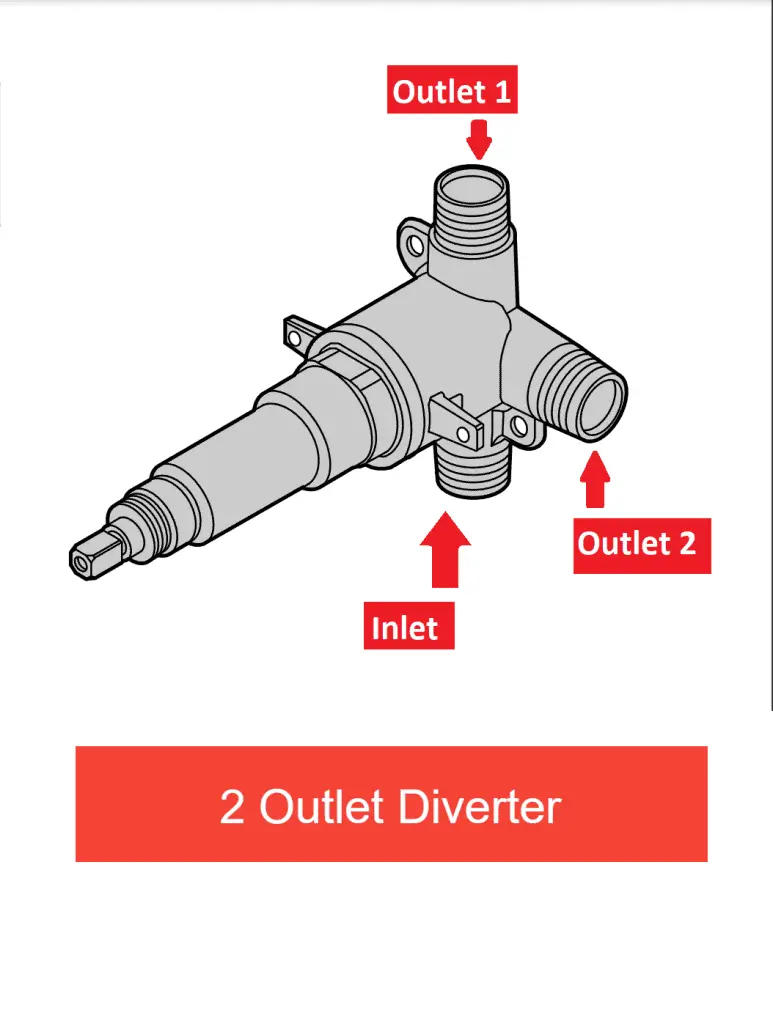

The trim is what you see when you walk in your shower, it’s simply a lever handle or knob that is fixed on a flange.
The valve body is a brass part typically comprised of 3 ports: 1 inlet port & 2 outlets. The inlet is where the water enters, the valve then divert the water to each outlet depending on your selection. It’s important to note that many 4 port diverters can be used as a 2 way diverter simply by plugging one of the ports.
A diverter unit is always accompanied by a main shower valve. Without this primary valve, the shower diverter is useless. When shopping for a standalone diverter, it’s often to double check and make sure the main valve is also included.
The appeal of the standalone diverter is that it makes the shower wall looks cleaner compared to the alternative. The types of diverters that sit on top of the main valve can look clunkier and more confusing to operate.
Two way diverters are most often used on a showerhead + handheld shower combination. However, they could also be used for a showerhead + tub spout combinations, as well as some lesser used 2 outlet setups.
It’s important to note that although it’s called a 2 way diverter, many diverters in this category allow for a third option which is the shared function. The shared function is when 2 outlets are being used as the same time. Some manufacturers might call this a 3 setting diverter, not to be confused with a “3 way diverter” which happens to be the second type on our list.
3 Way Diverter (Standalone)
As it names implies, the standalone 3 way diverter is also a separate diverter valve that allows for 3 functions instead of two. It’s comprised of a 4 port diverter with 1 inlet & 3 outlets as well as a finished trim with a handle used to switch between the 3 functions. The three way diverter is versatile and be used in a variety of applications.
- Showerhead + Handheld + Tub Spout
- Showerhead + Rainhead+ Handheld
- Showerhead + Body Sprays + Handheld
- Rainhead + Showerhead + Body Sprays
- etc..


Lastly, both the 2 & 3 way diverters can be installed alongside a volume control in a thermostatic valve system. This system is comprised of a main thermostatic valve which only controls temperature, a secondary volume control valve, & a standalone diverter to redirect the water to your desired position.
It’s more common to see a 3 way used as the volume control alternative because it saves the homeowner one additional piece of hardware on the shower wall. While this will work with a 2 way diverter, it will not provide any additional benefit. If anything, it’s a little more confusing to operate.
When a 3 way diverter has shared functions, it has an additional three settings to share water between the three different components. As a result, it may be referred to as a 6 setting diverter.
Push Button Diverter
The push button diverter is a type of diverter that comes pre-installed on a pressure balance valve. It is a user friendly and straightforward approach to diverter shower from one outlet to another. This type of diverter can either be push only or push & pull. It’s only used for 2 function shower system.
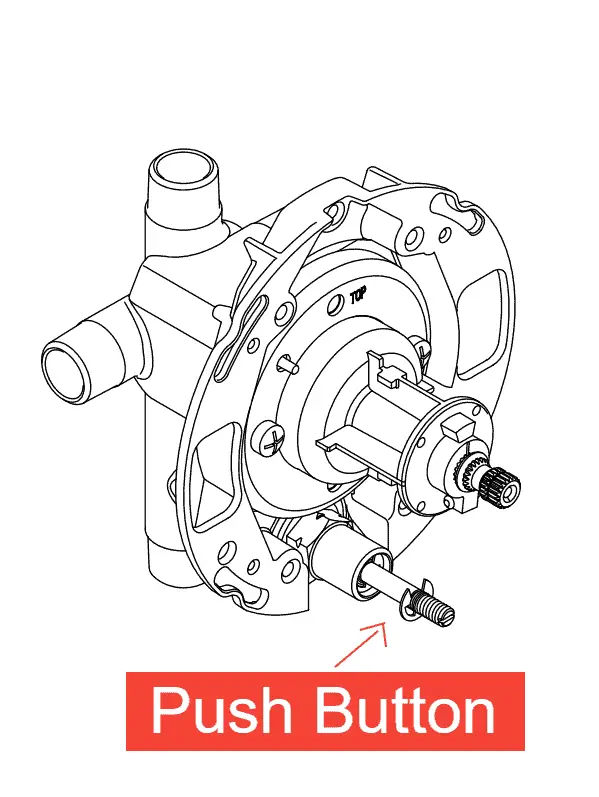


One of the drawback of a push button diverter is that there is no dial function. This means that the user has less control than the alternative. Each function is only fully off or turned on to full flow.
While the push button diverter can be used with handshower, it’s most commonly used a tub & shower application as an alternative to the diverter tub spout.
Integrated Diverter
An integrated diverter is a type of diverter that is built in the existing handle of the shower valve trim. It could be a sliding mechanism like the Symmons Temptrol line or a dial similar to Grohe’s integrated diverter trim. It could either be hanging from the main handle or positioned behind or on top of the existing control.
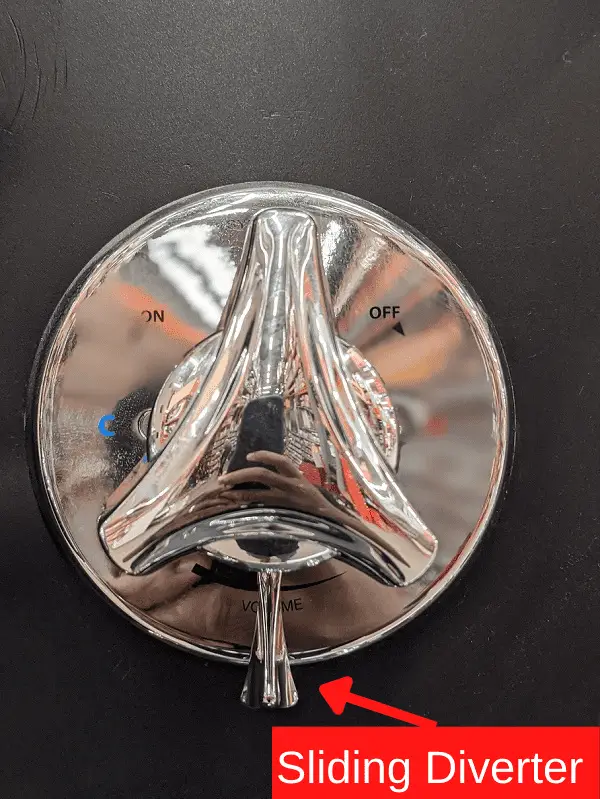

The benefit for this type of handle is that it offers more functionality than the push button diverter. There is a full range of flow you can dial in & out depending on your needs at the time. though it’s often bulkier than the push button option, it takes less space than the other alternatives.
The major drawback of this version is that it can be confusing to operate. Having two handles on top of each other can easily confuse a first time or occasional user.
Stacked Diverter
A stacked diverter is another 2 in 1 shower valve component where there is a full separate handle stacked on top or below the main valve handle. This could be either a lever handle, or a knob. It’s like having a standalone handle built in your existing valve trim.
The main advantage to this type of diverter is that it’ has all the function of a standalone diverter but it does not take any additional space on your shower wall. While some manufacturers limit this type of diverter to “either or” scenarios, others offer full fledged shared functions as well.


It is true that the integrated diverters offer the same functionality by taking less space but the stacked diverter is much more user friendly, as there is a clear distinction of the two handles. The main shower handle is typically larger to indicate that it’s the “on & off ” switch.
Shower Arm Diverters
Shower arm diverters a type of diverter used to add a handheld shower to an existing shower head. Because of the additional cost of in wall diverters, many homeowners decide to forego the additional outlet needed for a handshower. However, they typically regret this decision and decide to purchase a shower arm diverter instead.
We dove deeper on the shower arm diverter in a previous article detailing how to add a handheld shower to an existing showerhead.
4 Ways To Add A Handheld Showerhead To An Existing Shower
While they are cheaper and can help right a wrong, they make the shower area look busy & can be very clumsy to operate. In addition, there are limited options from high end brands & custom finishes.
Diverter Tub Spout
A diverter tub spout is a tub spout that has a built in diverter on top of its nose area. This type of diverter is only used for tub + shower applications. When turned on, the main shower valve sends water to the tub spout. You would then need to lift the diverter handle up to redirect the water to the shower head.
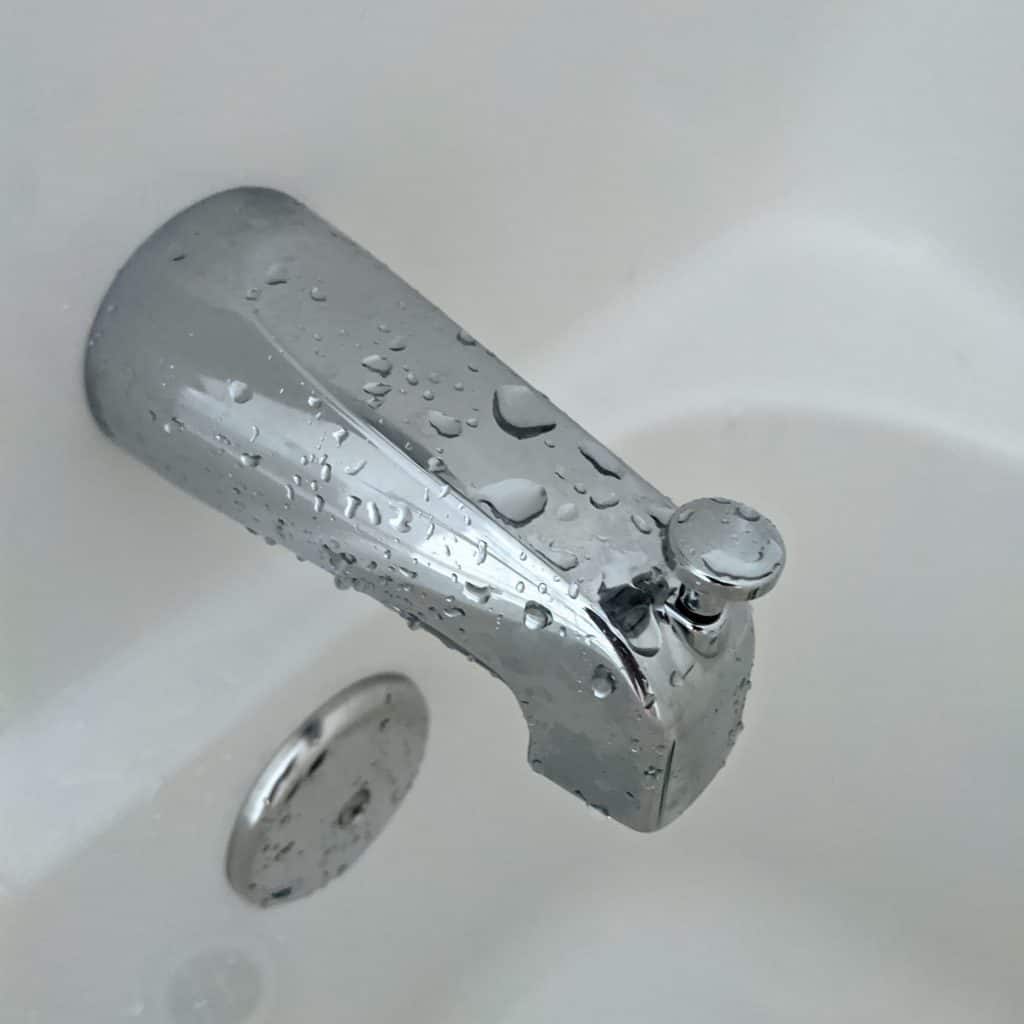

This type of diverter is affordable but can be clunky to operate. There is no way to directly turn on your shower without having to send water to the tub spout first. Also, you won’t be able to switch back & forth between the two. Once you have diverted the water to the showerhead, you will have to turn off the main valve, in order to send water to the tub spout.
It’s important to note that diverter tub spout can’t be used with a secondary diverter valve. They are only meant to be used as the only transferring mechanism in your shower. If you have a separate diverter elsewhere, you should instead purchase a non diverting tub spout.
Hot & Cold Diverter
This type of diverter is used for the traditional Hot & Cold shower valve. This type of diverter is dying out because the hot & cold shower valves do not have anti-scald functionality. An anti scaled system is starting to be a requirement in many states in the USA.
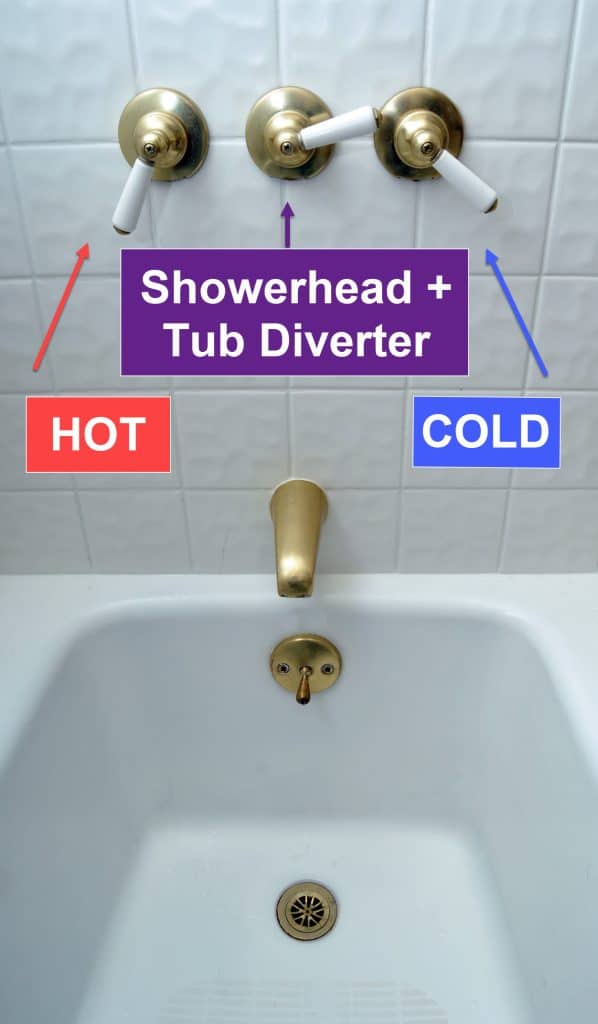
With this system, you would have to turn both the hot & cold water knob to your desired temperature. This function would send water to the tub spout below. The diverter handle is typically the middle handle would have be used to transfer water from the tub spout to the showerhead.
Why are there no 4 way Diverters?
High end custom showers can be equipped with four or more outlets, but shower manufacturers have shied away from producing a 4 way diverter.
There is simply no market for a 4 way diverter. While it’s technically possible to produce one, there are better and more desired alternatives, namely the thermostatic valve option. It is comprised of one Thermostatic valve & 4 Volume controls. The thermostatic valve’s main function is to control the temperature, while each volume control control each of the 4 outlets.
This setup gives you more flexibility and control when it comes to operating your shower. The thermostatic valve provide better consistent temperature and the volume control allow you to dial in the water volume exactly where you like it. In addition, you can pick and chose to have all outlets on at the same time. This is simply not possible with a diverter even the ones with shared functions.
Additionally, the thermostatic valve is able to provide more gallons per minute than a pressure balance valve. While you can technically use a diverter in conjunction with a thermostatic valve, the volume control is a much better partner for all the aforementioned reasons.
How to shop for a diverter valve
When shopping for a shower system with multiple outlets, it’s important to understand how you would like to transfer the water flow from one water to the next. If you want to operate each outlet individually & have them operate at full flow at the same time, it’s almost always better to opt for a thermostatic control with individual control for each outlet.
If that’s not a requirement, you should buy a diverter valve. Here is a simple guide to shopping for a diverter.
1. Pick a selection of your liking
Make sure this collection includes a diverter trim. Many manufacturers do not offer diverter trim on their entry level collections. At times, they might offer a push button diverter trim. However this push button diverter trim might only be compatible with tub spouts and showerhead, but not handheld showers.
2. Select a Pressure balance valve
This next step is crucial since your diverter needs to be accompanied by a main pressure balance valve. You will need to buy 2 separate items, the pressure balance valve, & its matching trim. Make sure that this valve & trim combination does not have a diverter built in, since those are not compatible with standalone diverter.
The pressure balance valve & trim have to be from the same brand & also compatible with each other. Some brands have multiple pressure balance valves. To minimize mistake, pick the trim first and the manufacturer would typically indicate its matching valve.
Push button & intergrated diverters are a little more straight forward as you would only need to buy the one trim & one valve that come with the diverter built in. You would need to skip step 3.
3. Select a diverter valve
This step is only for standalone diverters. You will again need to buy two parts, the diverter valve that goes inside the wall, as well as the diverter trim. These parts have to be from the same manufacturer & collection as your pressure balance valve. Make sure to pick a 2 or 3 way diverter valve depending on your needs.
Note that some 3 way diverter valves can be plugged by the plumber and turned into a 2 function diverter. There is no way to turn a 2 way valve into a 3 way.
4. Pick your shower heads, handheld shower, tub spouts etc..
It’s best to pick out matching shower heads from the same brand. However this is not a requirement. This is where you are allowed to venture a bit and pick out items from other brands if they do not meet your needs.
Here are some common reasons to pick parts from a different brand
- You prefer a more powerful shower head from a different manufacturer
- You would like a longer shower arm not offered by this particular collection
- You want a larger showerhead than what’s offered
- You would like a longer tub spout
- You prefer a metal handheld shower hose over the plastic ones offered by your existing collection.
We can go on & on but we would like to reiterate to stick with one brand whenever you are in doubt.


